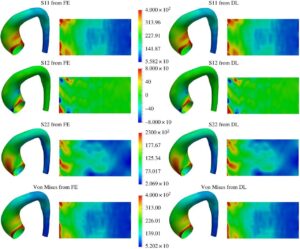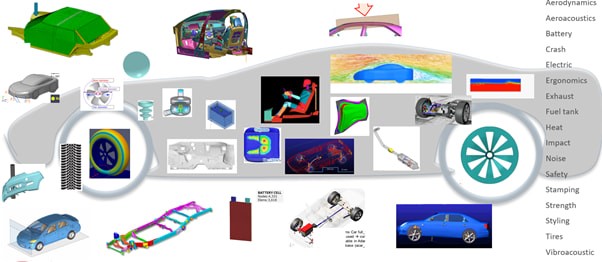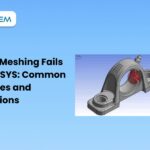Future FEA Engineers: Advances and Opportunities
Finite Element Analysis (FEA) has been a powerful tool for engineering simulation for several decades. It has revolutionized the way engineers design and analyze structures, mechanical systems, and other products. However, as technology advances and computational power increases, the future of FEA looks even more promising. In this article, we will explore some of the emerging trends and technologies that are shaping the future of FEA.
Artificial Intelligence (AI) and Machine Learning (ML) are revolutionizing the field of Finite Element Analysis (FEA). These technologies bring advanced capabilities and efficiency to FEA simulations. AI and ML techniques enable data-driven material characterization, automating the generation of FEA models, and adapting meshing based on stress distribution. They also facilitate predictive analysis, allowing engineers to forecast system behavior. Furthermore, AI can detect anomalies in simulation results, enhancing safety and reliability. ML-based optimization algorithms aid in design exploration, enabling engineers to efficiently explore design possibilities and find optimal solutions. The integration of AI and ML in FEA holds great potential for improving accuracy, accelerating processes, and driving innovation in engineering analysis.


Cloud computing is transforming the field of Finite Element Analysis (FEA) by providing scalable, flexible, and accessible computational resources. With cloud computing, FEA engineers can leverage the power of remote servers and virtual infrastructure to perform complex simulations without the need for extensive local hardware or software installations.
One of the key benefits of cloud computing in FEA is the ability to handle large-scale simulations. Cloud platforms offer high-performance computing capabilities, enabling engineers to solve computationally intensive FEA problems in a fraction of the time compared to traditional on-premises setups. This scalability allows for faster turnaround times and increased productivity in analyzing complex systems.
Cloud-based FEA also promotes collaboration and remote work. Engineers can easily share simulation models, results, and analysis reports with team members, regardless of their geographical location. This facilitates efficient collaboration, enabling multiple experts to contribute to a project simultaneously and accelerating the overall development process.
Another advantage of cloud computing is cost optimization. Instead of investing in expensive hardware and software licenses, FEA engineers can leverage cloud resources on a pay-as-you-go basis. Cloud service providers offer flexible pricing models, allowing users to scale resources up or down based on their specific needs. This approach reduces upfront costs and provides cost-efficiency for FEA projects, as users only pay for the resources they actually use.
Furthermore, cloud computing enhances data management and security. Cloud platforms offer robust data storage, backup, and recovery options, ensuring the integrity and availability of FEA models and results. With proper access controls and encryption mechanisms, cloud providers maintain a high level of security, safeguarding sensitive engineering data.
Overall, cloud computing revolutionizes FEA by providing on-demand computing power, enabling collaboration, optimizing costs, and enhancing data management and security. It empowers FEA engineers to tackle complex simulations efficiently and accelerates the overall engineering analysis workflow.

High-Performance Computing (HPC) plays a crucial role in advancing the capabilities of Finite Element Analysis (FEA) by significantly accelerating the computational performance and enabling complex simulations. HPC refers to the use of powerful computing systems that harness parallel processing and massive data throughput to solve computationally intensive problems.
FEA involves solving large systems of equations, which can be time-consuming for traditional computing resources. HPC provides a solution by distributing the workload across multiple processors or nodes, allowing for simultaneous computation and reducing the simulation time. This parallel processing capability empowers FEA engineers to tackle intricate models and perform parametric studies or design optimizations that were previously impractical or unfeasible.
HPC also enables the handling of massive datasets involved in FEA simulations. With the ability to process large amounts of data in a shorter time, engineers can perform detailed analyses and capture more accurate results. This is particularly beneficial for simulations involving complex geometries, high mesh densities, or multi-physics phenomena.
Additionally, HPC facilitates the exploration of design spaces and optimization in FEA. By leveraging the computational power of HPC clusters, engineers can efficiently evaluate multiple design iterations, perform sensitivity analyses, and conduct optimization studies. This empowers them to identify optimal solutions, enhance product performance, and streamline the design process.
Furthermore, HPC allows for the integration of advanced simulation techniques, such as fluid-structure interaction, multi-scale analysis, or coupled physics simulations. These techniques involve complex algorithms and increased computational requirements, which are efficiently handled by HPC systems. This enables engineers to accurately simulate real-world scenarios and capture the interactions between different physical phenomena.
In summary, HPC enhances FEA by significantly reducing simulation times, enabling complex simulations, handling large datasets, facilitating design exploration and optimization, and supporting advanced simulation techniques. By leveraging HPC resources, FEA engineers can push the boundaries of analysis capabilities, deliver more accurate results, and accelerate innovation in various fields, including aerospace, automotive, civil engineering, and more.

Virtual Reality (VR) and Augmented Reality (AR) are emerging technologies that hold great potential for enhancing the field of Finite Element Analysis (FEA) by providing immersive visualization and interactive experiences.
VR enables FEA engineers to step into a virtual environment where they can visualize and explore complex simulations in three dimensions. By wearing a VR headset, engineers can navigate through their FEA models, examine structural deformations, and observe the behavior of simulated systems from different perspectives. This immersive experience aids in understanding the intricate details of the analysis results, identifying potential issues, and gaining valuable insights into the behavior of structures.
AR, on the other hand, overlays virtual information onto the real-world environment, allowing FEA engineers to visualize FEA results within their physical surroundings. With the help of AR-enabled devices, engineers can superimpose stress contours, displacement vectors, or other analysis data directly onto physical prototypes or real structures. This integration of virtual and real elements provides a contextual understanding of the FEA results, enabling engineers to compare simulations with physical reality and make more informed decisions.
Both VR and AR technologies also facilitate collaborative design and analysis processes. FEA engineers can share their virtual environments or augmented views with team members or stakeholders, enabling them to collectively evaluate and discuss simulation results. This collaborative aspect improves communication, enhances understanding, and fosters efficient decision-making, particularly when working with multidisciplinary teams.
Moreover, VR and AR can assist in design review and validation. Engineers can virtually test different design iterations, explore alternative concepts, and assess the impact of design changes on structural performance. This interactive capability helps in identifying potential weaknesses, optimizing designs, and reducing the need for physical prototypes.
Furthermore, VR and AR can be employed in training and education. FEA concepts and simulations can be presented in an interactive and engaging manner, allowing students and new engineers to grasp complex analysis principles more easily. VR and AR environments can simulate real-world scenarios, enabling users to practice virtual experiments and develop a deeper understanding of FEA methodologies.
In summary, VR and AR technologies enhance FEA by providing immersive visualization, contextual understanding, collaborative experiences, design review capabilities, and educational opportunities. By leveraging these technologies, FEA engineers can improve their analysis workflows, gain valuable insights, and drive innovation in the field of engineering analysis.

Multidisciplinary Optimization (MDO) in Finite Element Analysis (FEA) is a powerful approach that combines multiple engineering disciplines to optimize the design of complex systems. MDO integrates FEA with other analysis disciplines such as structural analysis, fluid dynamics, thermal analysis, and electromagnetics to achieve the best possible design solutions.
The goal of MDO in FEA is to simultaneously optimize various performance objectives and constraints across different disciplines. By considering multiple disciplines, engineers can evaluate the interdependencies and interactions between different system components. For example, in the design of an aircraft wing, MDO can consider aerodynamics, structural integrity, weight reduction, and manufacturing constraints concurrently.
MDO leverages optimization algorithms to search for the optimal design configuration that satisfies performance targets while adhering to various constraints. These algorithms can automatically explore the design space, considering a wide range of parameters and variables, to identify the most favorable design solution. The optimization process can involve iterative analysis, adjusting design variables, and evaluating the impact on multiple disciplines using FEA simulations.
MDO in FEA offers several benefits. It enables engineers to uncover trade-offs and synergies between different design parameters and disciplines. By considering multiple aspects simultaneously, engineers can achieve better overall performance and more efficient designs. MDO also aids in reducing the need for costly and time-consuming design iterations, as the optimization process guides the search for the best design solution.
Moreover, MDO promotes collaboration among experts from various disciplines. By bringing together engineers specialized in different domains, MDO facilitates communication, knowledge sharing, and a holistic approach to design optimization. This interdisciplinary collaboration can lead to innovative solutions that would not be possible with isolated optimization efforts.
Additionally, MDO can drive the development of more sustainable designs. By considering factors such as weight reduction, energy efficiency, and material usage during the optimization process, engineers can design products that are environmentally friendly and resource-efficient.
In summary, Multidisciplinary Optimization in FEA integrates multiple engineering disciplines to achieve the best design solutions. By considering various performance objectives and constraints, MDO enables engineers to optimize designs across multiple disciplines simultaneously. This approach improves overall performance, reduces design iterations, promotes collaboration, and supports the development of sustainable designs.

Reference:
https://numericalarchive.com/2023/03/30/future-of-finite-element-analysis/#:~:text=In%20FEA%2C%20AI%20and%20ML,and%20cost%20required%20for%20simulations.




